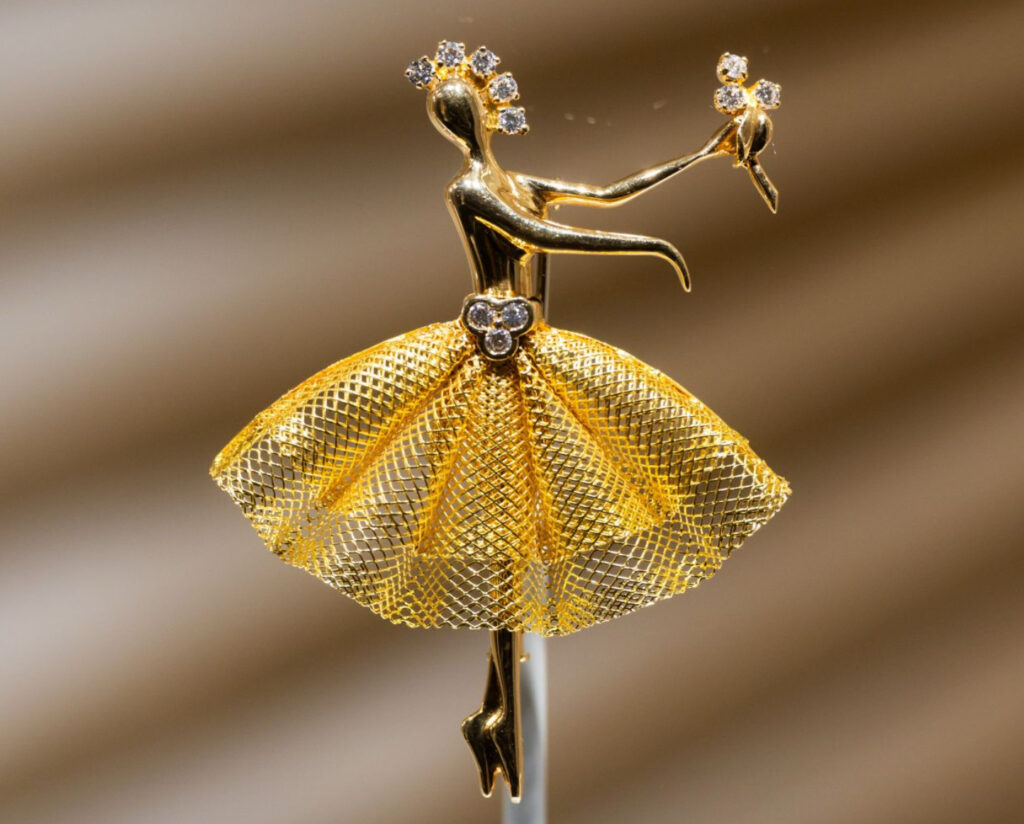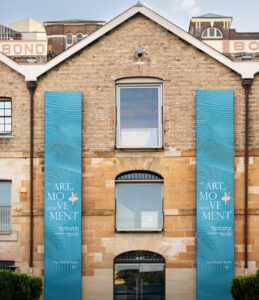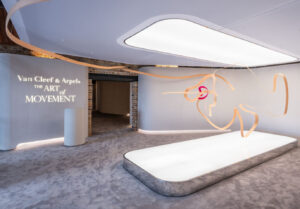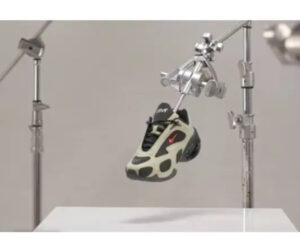


In a city where sandstone alleys and sea-salted air cradle modern ambition, Sydney welcomes a new occupant—not just a luxury exhibition, but a moving, shimmering embodiment of grace: The Art of Movement. Van Cleef & Arpels has chosen The Rocks as the site for its first-ever patrimonial exhibition in Oceania, and the result is less a retrospective than a living ballet of craftsmanship, memory, and kinetic elegance.
Curated with emotional intelligence and visual restraint, The Art of Movement arrives as both a celebratory landmark and a philosophical offering. More than 100 high jewelry pieces—each with their own aura of time, craft, and intention—stand amid 50 archival documents, arranged in a scenography inspired by the Maison’s iconic Silhouette Clip from 1937. At once ethereal and exacting, the display echoes the central theme of Van Cleef & Arpels: motion, not as haste, but as harmony.
An Exhibition in Motion
When one enters the exhibition, the first sensation is not opulence—it’s rhythm. Flowing, pleated textile panels shift delicately around the space, transforming light into gesture. These panels, crafted with couture precision, mimic the folds of a gown in mid-dance or the breath of silk caught in an updraft. They’re not just backdrops. They are movement itself.
The Maison’s dedication to movement as both muse and medium dates back nearly a century, and here, it’s sculpted into every element of the experience. Light bounces across gem surfaces like refracted time. Jewelry, positioned at precise intervals, appears almost airborne, as if caught in perpetual dance. This is not the stasis of a typical heritage show. This is choreography.
The Silhouette Clip and the Language of Fluidity
At the heart of the scenographic approach lies the Silhouette Clip, an emblematic piece from 1937 that speaks volumes with its curves. Rendered in white gold and diamonds, the clip was designed to evoke the outline of a woman’s figure in motion—a minimalistic abstraction of body, movement, and fabric. For this exhibition, that singular motif expands outward, becoming the architectural skeleton for the show itself.
Through this silhouette, Van Cleef & Arpels channels the modernist tradition of distillation: the art of saying more by showing less. It’s a gesture not of grandeur, but of grace.
Icons of Grace: Jewelry as Ballet
Movement, in the Van Cleef & Arpels universe, is most fully realized in its relationship to dance. Since the 1940s, the Maison has nurtured a deep association with ballet—most notably through collaborations with George Balanchine, the choreographer whose 1967 ballet Jewels drew direct inspiration from Van Cleef’s emeralds, rubies, and diamonds. In The Art of Movement, this thread remains vibrantly intact.
One section of the exhibit pays homage to this lyrical lineage through the presentation of ballerina clips—jeweled figurines poised mid-plié or caught in the grace of arabesque. Their skirts are mosaics of sapphires and spinels. Their torsos glimmer with pavé-set stones. They are less ornament than odes to motion.
The exhibition invites visitors to view these miniature dancers not merely as fine jewelry, but as crystallized moments of time. Here, technique becomes performance, and performance becomes memory.
Savoir-Faire in Motion
Integral to the Maison’s vision is its savoir-faire—a French term that evokes more than skill; it suggests a sensibility, an intimacy with the material world. The exhibition doesn’t simply show jewelry; it reveals how it’s made. Archival sketches, design blueprints, and early prototypes illustrate the journey from idea to artifact.
Particularly striking is a section dedicated to the Mystery Set technique, first patented by Van Cleef & Arpels in 1933. This method—where stones are set with no visible prongs or metal—requires such intense precision that only a few pieces are completed each year. In Sydney, the Mystery Set is honored as both innovation and poetry, a marriage of invisibility and brilliance.
Another highlight comes in the form of transformable pieces. Brooches become necklaces; pendants evolve into tiaras. These objects are designed not just to adorn, but to adapt—celebrating the motion not just of the body, but of time and taste.
A Jewel’s Journey: Heritage as Narrative
What sets The Art of Movement apart from typical brand exhibitions is its fidelity to narrative. Each piece is contextualized within its historical and cultural moment. A platinum clip from the 1920s is linked to the jazz rhythms of Paris. A diamond-and-enamel bracelet from the 1950s sits beside notes from the original workshop in Place Vendôme.
This framing reminds viewers that high jewelry is not static luxury. It is lived history. It passes through hands, necklines, generations. It embodies evolution—of style, technique, and perspective.
The archival documents displayed, many of which have never left the Maison’s vaults until now, serve as emotional anchors. These sketches, letters, and ledgers offer glimpses of creative struggle and epiphany. They transform precious objects into personal ones.
Australia: A New Stage
That this exhibition has arrived in Australia for the first time is significant. While Van Cleef & Arpels has long had a loyal following in Asia-Pacific, its patrimonial presence in Oceania has been comparatively minimal. With The Art of Movement, the Maison stakes not just a commercial footprint, but a cultural one.
The Rocks, with its history of trade, migration, and craftsmanship, forms a meaningful backdrop. There’s an echo between Van Cleef’s dedication to handwork and the artisanal pulse of the district’s cobbled streets and heritage façades. The exhibition doesn’t feel foreign—it feels fated.
Impression as Intimacy
In today’s hyper-visual, speed-obsessed culture, luxury often chases visibility. Van Cleef & Arpels, by contrast, moves slowly. Deliberately. It still believes in quiet opulence, in intimacy over impact. The Art of Movement reflects this ethos. There is no maximalism here, no algorithmic spectacle. Just silence, skill, and shimmer.
Visitors move through the space like participants in a ritual. They pause. They reflect. They absorb.
In this way, the exhibition becomes a form of collective breath—a cultural exhalation. One doesn’t leave merely impressed. One leaves realigned.
The Ephemeral as Eternal
Perhaps the greatest triumph of The Art of Movement is that it elevates the ephemeral. Dance disappears the moment it’s performed. Jewelry, by contrast, endures. But here, the two disciplines entwine.
The exhibition teaches us that endurance and transience are not opposites, but partners. A ballerina’s leap is gone in a heartbeat—but remembered forever in stone. A gold clip captures the fall of a skirt. A bracelet preserves the arc of an arm.
These pieces are not fixed—they’re vibrating.
Flow
As The Art of Movement closes its run in Sydney on May 8, it leaves behind more than impressions. It leaves behind a philosophy. That true luxury lies not in accumulation, but in attention. That motion is not chaos, but choreography. And that heritage is not a museum—it is a living rhythm, always evolving.
Van Cleef & Arpels reminds us that to move elegantly through the world is not a matter of speed, but of grace. And perhaps, in an age of digital velocity, that reminder is its own kind of treasure.
No comments yet.








